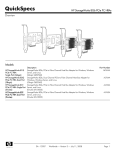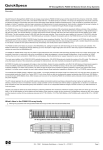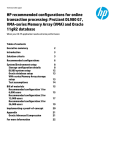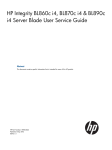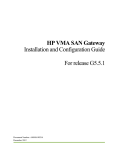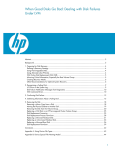Download HP VMA-series Memory Arrays Release Notes
Transcript
HP VMA SAN Gateway
for VMA-series Memory Arrays
Release Notes – November 2011
Table of contents
Introduction ......................................................................................................................................... 2
Features .......................................................................................................................................... 2
VMA features not initially supported by HP ............................................................................................. 3
Documentation location ........................................................................................................................ 3
Setup and configuration of the VMA SAN Gateway ................................................................................ 3
VMA SAN Gateway hardware configuration ...................................................................................... 3
VMA SAN Gateway software configuration ........................................................................................ 6
SAN connectivity with the VMA SAN Gateway ................................................................................... 7
Configuring and presenting LUNs to connected host servers .................................................................. 8
HP-supported host connectivity with VMA SAN Gateway.......................................................................... 8
Host configuration support matrix....................................................................................................... 8
Additional platform/OS specific considerations ................................................................................... 9
Supported web browsers with vSHARE GUI .......................................................................................... 12
VMA SAN Gateway: general recommendations and limitations .............................................................. 13
Alignment of data transfer I/O block sizes ........................................................................................ 13
Data layout structure alignment on VMA Array LUNs .......................................................................... 13
Tune application to issue I/Os which are multiple of 4KB ................................................................... 13
Create multiple LUNs for parallelization of I/O for applications .......................................................... 13
LUN 0 of the VMA SAN Gateway ................................................................................................... 13
Currently only 512B sectors are supported ........................................................................................ 14
Tune OS I/O queue depth settings for optimal performance ................................................................ 14
Increased I/O traffic from server reboot might cause reported path offline ............................................ 14
VMA v-commands available with the Gateway CLI............................................................................. 14
Setting date and time ..................................................................................................................... 14
CLI commands are case sensitive ..................................................................................................... 15
Backing up VMA SAN Gateway configuration for recovery .................................................................... 15
Data backup ..................................................................................................................................... 15
Open known problems ....................................................................................................................... 15
Open source code availability............................................................................................................. 16
For HP Technical Support.................................................................................................................... 16
In the United States ........................................................................................................................ 16
In other locations ........................................................................................................................... 16
For VMA drivers and firmware downloads............................................................................................ 16
For more information .......................................................................................................................... 17
Introduction
The VMA SAN Gateway provides additional scale of connectivity and availability for connecting host
servers using industry standard Fibre Channel to VMA-series Memory Arrays. The VMA SAN
Gateway acts as a storage controller that provides FC connectivity. The VMA SAN Gateway requires
a FC SAN switch between the gateway and the connecting servers.
The VMA SAN Gateway is a special purpose HP ProLiant DL380 G7 based storage controller
running a specially built and tuned operating environment, vSHARE OE, used for providing FC SAN
connectivity to one or two connected VMA-series Memory Arrays. VMA-series Memory Arrays are
connected using PCIe direct connect to the VMA SAN Gateway; the FC ports in the gateway act as
storage controller target ports for FC SAN connectivity to host servers. A maximum of two VMA-series
Arrays can be connected to the VMA SAN Gateway.
The HP VMA SAN Gateway is an appliance and can only be ordered with HP Product Number (P/N)
AM465A. The vSHARE OE cannot be ordered standalone and the VMA SAN Gateway cannot be
„built‟ from existing or new hardware.
Features
The VMA SAN Gateway provides the following features:
FC SAN connectivity of up to two VMA-series Memory Arrays
Standard four 8Gb FC target ports with option to add four additional ports
Special purpose vSHARE Operating Environment
CLI management interface
Web browser based GUI management interface
HP iLO 3 Standard functionality and remote management port
Redundant power supplies
RAID 1 mirroring of boot/operating environment disk
LAN and Serial management ports
For additional details on features, setup, commands, etc., see the HP VMA SAN Gateway Installation
and User Guide, document number AM456-9007A Rev 02, available at www.hp.com/go/vma-docs.
Figure 1: VMA SAN Gateway – front view
2
VMA features not initially supported by HP
The VMA-series memory arrays (VMA) and vSHARE OE are manufactured by Violin Memory. Not all
features and configurations possible with the VMA-series arrays and VMA SAN gateway have been
fully tested to the expected level from HP and are considered unsupported until a later time. While
the following features and configurations are described in the manuals, they are not initially
supported by HP:
iSCSI connectivity with the SAN Gateway is not supported at this time.
SAN Gateway feature called vCLUSTER for centralized management and monitoring of
gateways has not been fully tested.
Dual PCIe cables from a single array; this causes the PCIe cables to operate in slower x4
mode. Only a single PCIe connection from the VMA SAN Gateway to an array using the
Primary PCIe connection on the array is supported.
HP is not supporting connectivity to all the host platforms and operating systems (OSes)
mentioned in the manuals; only those listed in Table 2 have been fully tested to the level of HP
quality and are considered supported.
Only the VMA3205 (5TB) and VMA3210 (10TB) models are supported; other models with
other capacity and memory module capacities are not supported by HP at this time.
Documentation location
Applicable documentation for the HP VMA SAN Gateway and VMA-series Memory Arrays can be
found at www.hp.com/go/vma-docs
Setup and configuration of the VMA SAN Gateway
Additional information and details for connection and setup of the VMA SAN Gateway can be found
in the HP VMA SAN Gateway Installation and User Guide, document number AM456-9007A Rev
02, available at www.hp.com/go/vma-docs.
Configuration of the VMA SAN Gateway is comprised of the following steps:
1. VMA SAN Gateway Hardware Configuration
2. VMA SAN Gateway Software Configuration
3. SAN Connectivity with the VMA SAN Gateway
4. Configuring and Presenting LUNs to connected Host Servers
VMA SAN Gateway hardware configuration
The base VMA SAN Gateway, Part Number AM465A, comes with:
Two dual port 8Gb FC adapters (acting as four storage target ports)
Redundant (two) power supplies
Two 146GB SAS disks configured with RAID1 mirroring
Preloaded with the vSHARE software operating environment (OE)
HP Supports a maximum of two VMA-series Arrays connected to one VMA SAN Gateway. Each
VMA-series Array requires one VMA PCIe Pass Thru Card (P/N AM464A which must be ordered with
the array) installed in the VMA SAN Gateway and one PCIe cable connecting the VMA SAN
Gateway to the VMA Array. You can mix models of VMA-series Memory Arrays connected to the
VMA SAN Gateway.
3
Figure 2: VMA SAN Gateway – back view (P/N AM465A)
The FC HBA ports in the VMA SAN Gateway act as storage target ports which are connected to a FC
SAN Switch to provide host initiator port connectivity. The VMA SAN Gateway is only supported
with SAN Fabric attach; FC direct attach from a server FC port to a FC port on the gateway is not
supported. It is recommended that no more than two dual port 8Gb FC adapters (four target ports)
be deployed in the VMA SAN Gateway for each VMA-series Memory Array connected to avoid over
subscribing gateway and array resources. Four 8Gb FC ports (two dual port HBAs) are sufficient to
attain full I/O bandwidth of a single connected VMA-series array.
VMA-series Memory Arrays are connected to the VMA SAN Gateway using the VMA PCIe Pass-Thru
Card and directly connecting from the PCIe Pass Thru Card port to the Primary PCIe port of the VMAseries Memory Array using the VMA 3-meter PCIe cable that ships with the VMA array.
Important: The VMA PCIe Pass-Thru cards must only be inserted into I/O slots 1 or 4 of the
VMA SAN Gateway (see above). The two FC 8Gb dual port adapters, which come with the
VMA SAN Gateway, are pre-inserted into I/O slots 2 and 3 of the gateway. If two VMAseries Memory Arrays will be connected to the gateway, it is advised to order two additional
dual port 8Gb FC adapters, P/N AJ764A, for insertion into I/O slots 5 and 6. The VMA
SAN Gateway supports a maximum of two VMA-series Arrays and four dual port 8Gb FC
adapters (P/N AJ764A).
Note that the VMA PCIe cables and VMA Pass-Thru adapter card are not hot-pluggable. Connection
from the VMA SAN Gateway to the primary port of the VMA-series Array will require you to power
down the VMA SAN Gateway and the VMA Array. In order to have the PCIe busses of the VMA
array correctly connect electronically, you need to first power up the VMA array, wait until the PCIe
bus indicators light (about a minute) and then power up the VMA SAN Gateway. If the VMA SAN
Gateway is powered up before the VMA Array, the VMA array may not identify and be discovered
by the VMA SAN Gateway.
Only SAN attach is supported, meaning that connections from host servers to the SAN Gateway must
connect through a Fibre Channel SAN switch; direct FC attach from host server to SAN Gateway is
not supported.
One VMA PCIe Pass-Thru card must be ordered with each VMA-series Memory Array. Note that the
VMA PCIe cable is connected to the Primary PCIe port of the VMA-series Memory Array which is the
left-most port when viewing the back of the array.
4
Figure 3: VMA-series Memory Array – back view showing PCIe ports
The following figures show how to properly insert the VMA PCIe Pass-Thru and Optional 8Gb FC dual
port adapters. If you specify factory integration (option 0D1) with your order of a VMA SAN
Gateway and one or two VMA-series Memory Arrays, the resulting racked and shipped configuration
will appear as depicted below. See Figure 4 for a single VMA-Series Memory Array configuration
and Figure 5 for correct and supported connection of two VMA-series Memory Arrays.
Figure 4: Correct connections for one VMA-series Memory Array to one VMA SAN Gateway
If two VMA-series Memory Arrays are connected to the gateway, it is recommended to add two
additional 8Gb FC adaptors, Part Number AJ764A, for a maximum total of eight FC target ports
supported with the VMA SAN Gateway.
5
Figure 5: Correct connections for two VMA-series Memory Arrays to one VMA SAN Gateway
VMA SAN Gateway software configuration
Please take time to review the HP VMA SAN Gateway Installation and User Guide to become familiar
with the available commands and features.
On first login to the VMA SAN Gateway, you will be prompted if you want to run the setup wizard. It
is recommended to use the setup wizard at this time so that you can enter key configuration
parameters required before you can begin using the VMA SAN Gateway with connected VMA-series
Memory Arrays. The setup wizard guides you through entering configuration settings for such things
as:
VMA SAN Gateway IP address
Ethernet interface to use
DNS server IP address
Site domain name
Changing the default Gateway Hostname
Setting a password
Setting the Time and Time source
E-mail notification settings
Chapter 3 of the HP VMA SAN Gateway Installation and User Guide (document number AM4569007A Rev 2) provides guidance for setting up the software configuration of the VMA SAN
Gateway. You can re-run the setup wizard at a later time by using the command configuration
jump-start.
6
Note that the title of Chapter 3, Configuring and Managing Clusters, in the HP VMA SAN Gateway
Installation and User Guide is somewhat misleading. The VMA SAN Gateway operating environment
has the ability to configure gateways in a master and slave(s) relationship to provide for single point
of management and monitoring of all member nodes. This „cluster‟ feature, termed as vCLUSTER in
the document, is only applicable to gateway management and monitoring functions and does not
provide for high availability or redundant gateway configurations for access to connected VMA
arrays. The vCLUSTER feature allowing master/slave relationship of gateways for single point of
management and monitoring member gateway nodes has not been fully tested and is not supported
by HP at this time. Currently, only standalone VMA SAN Gateways with singly PCIe connected VMA
arrays are supported by HP. There is no requirement for a private VLAN with standalone gateways.
In order to correctly configure the VMA SAN Gateway as a „standalone gateway‟, follow the
procedures for Configuring the Master Memory Gateway in Chapter 3 of the HP VMA SAN Gateway
Installation and User Guide. The software configuration and setup is the same for a standalone or
master gateway except for the following vCLUSTER specific settings which can be ignored and left at
the default values presented with the setup wizard:
Cluster interface name
Cluster expected nodes – this should be defaulted to „1‟ for standalone.
Cluster id – the Cluster ID is already preset from the HP factory and should be left as is.
Any change of the cluster id value can cause the gateway to not operate correctly. The
Cluster ID and vSHARE license for the VMA SAN Gateway is listed on a label located on the
front right top of the gateway server if it is ever needed for recovery.
Cluster name
Cluster management IP address & netmask
In addition, the following sections in Chapter 3 are not applicable for setting up a standalone VMA
SAN Gateway:
Interface Bonding
Cluster VLAN Configuration
Configuring Additional Gateways
Memory Gateway Cluster Management
SAN connectivity with the VMA SAN Gateway
The VMA SAN Gateway is only supported with Fabric SAN attach topology. Direct connect of VMA
SAN Gateway target ports to a host server‟s initiator ports are not supported; nor are any FC-Loop
topologies. SAN Attach provides added distance, availability and sharing of the connected storage
in the VMA-series Memory Arrays.
The VMA SAN Gateway and connected VMA-series Memory Arrays are best when used in small
groups of two to four connected host servers providing support for a few application services which
require very high performance and low latency I/O operations. While FC SAN does provide much
scale-out capability, the VMA SAN Gateway and connected VMA-series Memory Arrays should not
be considered as general purpose storage and allow connectivity with many sharing hosts. Doing
such can potentially cause degraded performance and excessive I/O resource contention.
There are no special drivers needed to be installed on the connecting host server nodes; standard
8Gb FC HBAs are used for host server connectivity. Supported Fibre Channel adapters and drivers
for the supported HP server platforms and operating systems are listed in Table 2.
The VMA SAN Gateway web GUI and CLI commands associate the available FC target ports with the
following port names. Refer to Figure 2 above for I/O slot numbering.
7
Table 1. VMA SAN Gateway FC target port naming.
VMA SAN Gateway
HBA I/O Slot #
Target Port Name
Left Port
Right Port
2
hba-a1
hba-a2
3
hba-b1
hba-b2
5 (if present)
hba-c1
hba-c2
6 (if present)
hba-d1
hba-d2
Note that only the FC HBAs installed in I/O slots #2 and #3 come with the default configuration of
the VMA SAN Gateway. The FC target HBAs in I/O slots #5 and #6 are optional and will only be
present if ordered as add-on components, P/N AJ764A. As mentioned previously and shown in
Figures 4 and 5, it is recommended to have only two HBAs, four target ports, per connected VMA
array.
Configuring and presenting LUNs to connected host servers
The VMA SAN Gateway provides the ability to selectively present LUNs through specific gateway
target ports and to specific host server initiator ports. Refer to the Chapter 4, “Configuring vSHARE”
in the HP VMA SAN Gateway Installation and User Guide for additional details regarding LUN
configuration and selective host presentation and LUN masking.
The VMA SAN Gateway has a maximum queue depth limit of 1024 per 8Gb FC target port. There is
an additional LUN maximum queue depth limit of 256. Connecting host servers must establish
appropriate I/O queue depth settings in order to achieve optimal performance with the VMA SAN
Gateway and avoid heavy FC resource contention and excessive I/O retries. Refer to the section
below titled „Additional Platform/OS Specific Considerations‟ for additional details regarding
establishing appropriate queue depth settings for specific platform/OS combinations.
It is recommended not to configure more than 32 LUNs per connected VMA-series Array at this time.
It is also recommended not to exceed more than eight initiator ports per connected server for optimal
usage; greater numbers of LUNs and initiator ports can cause FC resource contention and excessive
retry traffic. Because the VMA-series Memory Arrays and the VMA SAN Gateway are focused for
specific application environments which require very high I/O throughput with extremely low latency
times, it is also recommended that it not be connected to more than four host servers or partitions for
optimal results.
HP-supported host connectivity with VMA SAN Gateway
While other configurations of the VMA SAN Gateway may be possible, only the following
configurations have been fully tested and are supported by HP at the release of this document. If you
are using a configuration not listed below as a supported configuration, you may be asked to
reconfigure your environment to comply with a supported configuration for HP support entitlement.
Host configuration support matrix
The VMA SAN Gateway with vSHARE version G5.0.2 has been tested and is supported with the
following HP server platforms and operating systems:
Integrity BL8x0c i2 server blades running HP-UX 11i v3 fusion 1109 or newer
Integrity Superdome 2 running HP-UX 11i v3 fusion 1109 or newer
8
ProLiant DL980 G7 running RHEL 5.7
ProLiant DL980 G7 running SLES 11 SP1
ProLiant DL980 G7 running Windows Server 2008 R2 & R2 SP1
For additional details about supported servers, operating systems and FC HBAs, see the following
table:
Table 2. VMA SAN Gateway support matrix.
Server
Platform
Operating
System &
Version
Platform
Firmware
FC HBAs
FC Driver
Version
FC SAN
Switches
BL8x0c i2
HP-UX 11i v3
update 9
(fusion 1109)
or newer
K26.05
451871-B21,
456972-B21
Fusion 1109 or newer
B-Series
C-Series
H-Series
AH400A,
AH401A,
AH402A,
AH403A
Fusion 1109 or newer
B-Series
C-Series
H-Series
AJ762A,
AJ763A,
AJ764A,
AK344A
Included in distro:
B-Series
C-Series
H-Series
Superdome 2
HP-UX 11i v3
update 9
(fusion 1109)
or newer
DL980 G7
RHEL 5.7
DL980 G7
DL980 G7
SLES 11 SP1
Windows
Server 2008 R2
and R2 SP1
Non-VC and
VC connectivity
(VC f/w 3.18)
2.16b
BIOS
2011.06.24
BIOS
2011.06.24
BIOS
2011.06.24
AJ762A,
AJ763A,
AJ764A,
AK344A
AJ762A,
AJ763A,
AJ764A,
AK344A
8.03.07.03.05.07-k
for AJ764 & AK344A
8.2.0.96.2p for
AJ762A & AJ763A
Included in distro:
8.03.01.06.11.1-k8
for AJ764 & AK344A
8.3.5.8.1p for
AJ762A & AJ763A
7.2.43.0 for AJ762A
& AJ763A
9.1.9.26 for AJ764A
B-Series
C-Series
H-Series
B-Series
C-Series
H-Series
& AK344A
Additional platform/OS specific considerations
The following sections provide additional server platform and operating system specific supported
configuration considerations and recommendations.
HP-UX 11i v3
The Integrity Superdome 2 and BL8x0c i2 server blades require HP-UX 11i v3 update 9 (fusion 1109)
or newer when connecting to the VMA SAN Gateway with VMA-series Memory Arrays. The
following subsections describe additional limitations and considerations when using HP-UX 11i v3.
Must Use Agile View – No Legacy View Support
The VMA SAN Gateway is only supported with the „Agile View‟ and Persistent DSFs of HP-UX 11i v3
Mass Storage Stack. The VMA SAN Gateway does not support SCSI Volume Set Addressing and
therefore is not supported with the Legacy View mode of HP-UX 11i v3. This is because the VMA
9
SAN Gateway only supports the de facto standard Peripheral Device Addressing (PDA) mode.
Legacy mode requires Volume Set Addressing (VSA) for targets which support greater than 8 LUNs
(LUN IDs 0-7) attached. The „Agile View‟ of HP-UX 11i v3 Mass Storage Stack supports both PDA
and VSA addressing modes for storage devices and also provides I/O and connectivity support well
beyond 11i v2 limits. The backward compatible „Legacy View‟ support delivered with HP-UX 11i v3
is scheduled to be deprecated with the next major release of HP-UX.
Similarly you must only use the „Agile View‟ capabilities of management utilities such as System
Management Homepage (SMH) when managing LUNs created on the VMA array so that all LUNs
beyond LUN ID 7 are viewable and manageable.
Do Not Create a LUN 0 on the VMA Array
One of the values of HP-UX, especially the 11i v3 release, is commitment and focus on data integrity.
With 11i v3 and ability to bind DSFs to LUN WWIDs, we are also able to ensure that when a storage
device/LUN replacement is made that it is intentional. If there is a device with a new LUN WWID
connected to where a device was previously connected and only the LUN WWID has changed, HPUX 11i v3 asks for authorization to allow that replacement of device before allowing access,
especially writing to it, which could cause accidental data loss if it was not the correct device nor
intended to be a replacement device. For this reason it is recommended to not explicitly configure a
LUN ID 0 on the VMA SAN Gateway as any change or inability to access the created LUN 0 could
cause inaccessibility to all LUNs and stored data.
Queue-Depth Settings Using TPCC with HP-UX 11i v3
It is highly recommended to use the Target Port Congestion Control (TPCC) feature available with the
HP-UX 11i v3 Mass Storage Stack to manage and control I/O queue depth with the VMA SAN
Gateway. For additional information and usage of TPCC, see the “HP-UX 11i v3 Congestion Control
Management for Storage White Paper” available at:
http://h20000.www2.hp.com/bc/docs/support/SupportManual/c02054623/c02054623.pdf
Use the following table to determine appropriate TPCC settings with HP-UX 11i v3 for your
environment:
Table 3. HP-UX 11i v3 TPCC queue depth values.
IF
THEN TPCC Setting is
I/Os are 4KB aligned and < 256KB
1024 / number of servers*
I/Os are 4KB aligned and > 256KB
512 / number of servers*
I/Os are NON-4KB aligned and < 256KB
512 / number of servers*
I/Os are NON-4KB aligned and > 256KB
256 / number of servers*
* where servers can be a whole physical server or a partition.
Linux
The Linux distros RHEL 5.7 and SLES 11 SP1 have been validated on the DL980 G7 server with the
HP VMA SAN Gateway and connected VMA-series Memory Arrays. Additional limitations and
considerations for Linux environments are shared in the following subsections.
10
Recommended Multipath Settings
For Linux environments, it is recommended to change from the default settings for multipathing. For
heavily loaded I/O environments, such as with the VMA SAN Gateway, it has proven to be more
efficient to use the „tur‟ checker method instead of the „readsector0‟ or „directio‟ alternatives to check
the health of lunpaths. An example multipath setting would be:
devices {
device {
vendor
product
path_grouping_policy
path_checker
getuid_callout
path_selector
failback
rr_weight
rr_min_io
}
"VIOLIN "
"SAN ARRAY
"
multibus
tur
"/sbin/scsi_id -g -u -s /block/%n"
"round-robin 0"
immediate
uniform
20
}
The „rr_min_io‟ value denotes the minimum number of I/O operations to send down the current
lunpath before selecting the next lunpath. A lower value than typically used with standard rotational
media storage array controllers has proven better to keep all lunpaths busy. This value could be
further tuned for your specific environment based on workload and number of lunpaths.
Queue-Depth Settings for SLES 11 SP1 and RHEL 5.7
The HBA drivers used with Linux have default LUN level queue depth values of 30 or 32 depending
upon the HBA vendor. In many cases this default value will provide good results. However in cases
where a large number of LUNs are used with a large number of server FC initiator ports, the resulting
I/O load could cause Queue-Full conditions and I/O retries leading to non-optimal performance.
For optimal I/O performance use, the following equation to determine the LUN queue depth settings
for the FC HBA driver:
LUN Queue Depth value =
(( <# gateway FC target ports> * 1024) / <# of server FC initiator ports> / <# of LUNs>)
If the resulting LUN Queue Depth value is greater than the HBA driver default (usually 30 or 32), then
use driver default setting.
Windows
Microsoft Windows Server 2008 R2 and Windows 2008 R2 SP1 releases have been validated on
the DL980 G7 server with the HP VMA SAN Gateway and connected VMA-series Memory Arrays. It
is recommended to apply all the latest patches and MPIO QFEs before connecting your system to the
VMA SAN Gateway appliance. Some additional limitations and considerations for Windows Server
2008 R2 and R2 SP1 environments are presented in the following subsections.
Recommended MPIO Changes:
It is recommended to ensure that MPIO is enabled and correctly configuring MPIO for LUNs presented
by the VMA SAN Gateway. If MPIO is not already enabled and active on the server, perform the
following steps to activate it:
1.
Click:
START -> Administrative Tools -> Server Manager -> Features.
2.
Click Add Features.
11
3.
Check the box for MPIO and install.
4.
Reboot the server to initialize MPIO and claim devices.
Verify that MPIO has correctly identified the LUNs presented by the VMA SAN Gateway with the
following steps:
1.
Click:
START -> Administrative Tools -> MPIO
2.
Under the MPIO Devices tab, verify that there is a Device Hardware ID entry for „VIOLIN SAN ARRAY
„ in the list of IDs. There will be a generic Device Hardware Id template entry, „Vendor8 Product
16‟
which is only an example entry and does not bind to any storage. It is okay to leave this template entry
in the list.
3.
Only if an entry is not in the Device Hardware ID table for „VIOLIN SAN ARRAY
mpclaim function to re-identify devices for MPIO management. Click:
START -> Run -> cmd -> enter the command: mpclaim.exe -r -i -a ""
4.
The system will automatically reboot after running the mpclaim command.
5.
To validate the MPIO settings, click:
START -> Administrative Tools -> Computer Management -> Disk Management, and you
can validate the number of disks you have created and presented to this server from the VMA SAN
Gateway.
„, try issuing the
Queue-Depth Settings for Windows 2008 R2 & R2 SP1
The HBA drivers used with Windows Server 2008 have default LUN level queue depth values of 30
or 32 depending upon the HBA vendor. In many cases this default value will provide good results.
However in cases where a large number of LUNs are used with a large number of server FC initiator
ports, the resulting I/O load could cause Queue-Full conditions and I/O retries leading to non-optimal
performance.
For optimal I/O performance, use the following equation to determine the LUN queue depth settings
for the FC HBA driver:
LUN Queue Depth value =
(( <# gateway FC target ports> * 1024) / <# of server FC initiator ports> / <# of LUNs>)
If the resulting LUN Queue Depth value is greater than the HBA driver default (usually 30 or 32), then
use driver default.
Supported web browsers with vSHARE GUI
To launch the vSHARE web-based GUI, enter the VMA SAN Gateway IP address in the web address
space of the web browser. The vSHARE GUI requires the Java plug-in to be added and enabled in
the web browser in order to function correctly. Supported web browsers for use with the vSHARE
web-based GUI are:
Internet Explorer (IE) version 8 or newer. When using IE, disable IE compatibility mode:
(Tools -> „Compatibility View Settings‟ ->
uncheck „Display Intranet sites in Compatibility View‟)
Mozilla Firefox version 3 or newer
12
VMA SAN Gateway: general recommendations and
limitations
The following are general recommendations for getting optimal performance with the HP VMA SAN
Gateway and connected HP VMA-series Memory Arrays.
Alignment of data transfer I/O block sizes
The internal flash addressing of the VMA is based on 4K (4096) byte boundaries. Read or write
requests that do not begin on a 4KB aligned target block address or are of I/O sizes not a multiple of
4KB might suffer a performance impact. Write performance is more seriously affected by non-4KB
alignment. For example, if a user application writes 512 bytes starting at the last 256 bytes of a 4K
page, the result on hardware would be two 4K read-modify-write updates.
In order to achieve optimal throughput and performance with the VMA-series Memory Arrays, care
should be given to tuning the intended application, data layout structures on the array, and the
connected host server.
Data layout structure alignment on VMA Array LUNs
The data layout structures created on the VMA LUNs by a logical volume manager and file system on
the host should be made so that they are 4KB aligned, meaning that partition sizes, LVM striping and
other data structures are 4KB aligned. Consider the following when creating data layout structures on
the VMA:
Partition sizes are 4KB aligned
Volume manager stripe sizes are multiple of 4KB
File system blocks are 4KB aligned
Tune application to issue I/Os which are multiple of 4KB
Most high level applications can be configured to issue certain I/O block sizes for increased
performance. Ensure that configured I/O block size and if appropriate the beginning block
addresses for I/Os are 4KB aligned.
Create multiple LUNs for parallelization of I/O for applications
Creating multiple LUNs on the connected VMA arrays might allow applications to launch multiple
threads for greater I/O parallelism and performance. It is currently recommended to configure no
more than 32 LUNs with this initial release of the VMA SAN Gateway.
LUN 0 of the VMA SAN Gateway
LUN 0 is considered a reserved device and various issues can occur if LUN 0 is not accessible by all
connected host servers. Thus, the VMA SAN Gateway will prompt for configured LUNs to begin with
LUN ID #1. If a specific operating system requires configuration of a LUN ID #0, this can be done by
explicitly entering „0‟ for the LUN ID when creating a LUN. However, any configuration changes or
accessibility change to an explicitly created LUN ID #0 might cause disruption of service including
inability to discover and access LUNs and stored data to other connected server hosts.
13
Currently only 512B sectors are supported
While the VMA SAN Gateway will allow creation of LUNs with either a 512B or 4KB sector size,
only 512B sector size has been fully tested and supported with the gateway. LUNs using 4KB sectors
have not been fully validated and are not considered supported by HP at this time.
Tune OS I/O queue depth settings for optimal performance
Refer to and follow the guidelines for setting OS specific I/O queue depth for I/O to the VMA SAN
Gateway. If the I/O queue depth settings are too high, you might experience the following due to the
SAN Gateway or VMA array being overwhelmed with I/O requests:
Queue-Full SCSI status
SCSI Check Condition: Sense Key=0x06 ASC/ASCQ=0x29/0x07 (Nexus Lost)
I/O time outs resulting in host initiated I/O aborts
Incomplete CDB Status 0x400 - when an I/O times out before it can be sent
Target Ports going offline and then coming back online
Duplicate sessions (see „Known Problems‟ section)
When you see the above messages, try lowering the current LUN queue depth or TPCC settings to see
if with additional tuning the diagnostic messages are no longer encountered. Usually the above
diagnostic messages and other issues result from connected host servers exhausting the available I/O
resources on the VMA SAN Gateway.
Increased I/O traffic from server reboot might cause reported path
offline
As with all storage, when a connected host server reboots there is additional I/O activity that can be
higher than normal I/O traffic volume. This added I/O traffic from a server reboot might cause some
I/Os to the SAN Gateway to time out and might be reported as a path being offline or failing. In
such cases, I/Os are retried by the host server and the path is detected as back online shortly
thereafter.
VMA v-commands available with the Gateway CLI
A number of the VMA Array “v” commands are also available with the Gateway CLI:
vspeedtest (performs a quick test of read speed with the array)
vincident collects information on attached arrays
vmesg lists the debug messages on the Gateway
vvimms, varray, veeprom, vinfo provide configuration information on the array
vstat displays array status
vpartial shows partial/unaligned array I/O counters
vcounts displays array I/O counts
vzero resets the array I/O counters
Setting date and time
It is recommended to set the correct date and time on your VMA SAN Gateway and VMA-series array
when initially installed and configured. Setting the correct date and time will help with correlation
and analysis of host server, gateway and array events if a problem is reported.
14
CLI commands are case sensitive
All CLI commands are case sensitive and usually are all lower case. CLI commands are documented
in appendices of the user manuals.
Backing up VMA SAN Gateway configuration for recovery
For disaster recovery of the VMA SAN Gateway configuration file, you can create a copy of the
gateway configuration file and upload it to a production or maintenance server to be included in the
regular data backup of that server. When required to recover the gateway configuration file you can
restore it to the server and then from the gateway issue a „fetch‟ to retrieve it back to the gateway.
First create a copy of the current active configuration on the VMA SAN Gateway to a configuration
file, using the configuration write command:
# configuration write to <file-name>
Next step is to copy the saved gateway configuration file to the production or maintenance server
using the configuration upload command so that it can be included in regularly scheduled data
backups:
# configuration upload <file-name> scp://<user-login>[:<password>]@<server IP>/<targetdirectory>[/<file-name>]
When required to recover the gateway configuration file, you can retrieve the restored configuration
file from the production or maintenance server by issuing the configuration fetch command:
# configuration fetch scp://<user-login>[:<password>]@<server-IP>/<sourcedirectory>/<source-file-name> [<gateway-file-name>]
Data backup
As with any data storage device, array or system, data stored should always be protected with a
regular data backup schedule that is appropriate for the criticalness of the data stored. You can use
the HP Data Protector software or your chosen backup software utility to back up your data on the
VMA as done with other standard rotational disk-based storage systems.
Open known problems
Duplicate sessions might appear under heavy I/O load. At times when an initiator port logs
out and then logs in before its prior session has been completely removed from the active
sessions table, a duplicate session with a suffix of „_#‟ will be displayed when displaying active
sessions of a target port or LUN. These duplicate sessions with the mentioned suffix are benign,
do not consume any resources and are removed with the next reboot of the gateway. The
current active session does not have the suffix. As an example:
Port:
Port:
Port:
Port:
hba-a1,
hba-a1,
hba-a1,
hba-a1,
Session:
Session:
Session:
Session:
50:01:43:80:04:26:6f:80_1, LUN ID: 1
50:01:43:80:00:c5:c1:90, LUN ID: 1
50:01:43:80:04:26:6f:80, LUN ID: 1
50:01:43:80:00:c5:c1:90_1, LUN ID: 1
Diagnostic messages if exceeding gateway resources. These diagnostic messages could
include notification of target ports going offline then online, I/O timeouts followed by I/O
aborts, Queue Full status, and other similar warnings. To alleviate these instances, use
appropriate Queue-Depth settings and management as stated above in this document.
Gateway shutdown during export of LUNs will log an error event. An immediate shutdown of
the VMA SAN Gateway while it is performing a LUN export will cause an error event to be
15
logged and e-mail notification indicating that a process was killed. When the gateway is
restarted, the gateway will re-export the LUNs.
Web browser based vSHARE GUI might log out due to inactivity even though there is activity.
LUN presentation and export rules need to be changed to reflect initiator port changes if a host
HBA fails, is removed or is replaced.
Fetch of a vSHARE configuration file which has a different vSHARE Cluster ID and different
vSHARE license will take the gateway offline and results in an error message.
The ip filter command does not work with this release. If the ip filter command is
used, it will save the entered filter configuration, but it will not take effect. However a warning
will be generated in the logs reporting there is an error with the ip table.
Open source code availability
The specially developed vSHARE OE which is integrated with the VMA SAN Gateway appliance
includes some open source components. Source code for these open source components is available
on the HP Business Support Center – Driver and Software Download web page for the VMA3205
and VMA3210.
For HP Technical Support
In the United States
For contact options, see the Contact HP United States webpage at:
http://welcome.hp.com/country/us/en/contact_us.html.
Call 1-800-HP-INVENT (1-800-474-6836). This service is available 24 hours a day, 7 days a
week. For continuous quality improvement, calls may be recorded or monitored.
If you have purchased a Care Pack (service upgrade), call 1-800-633-3600. For more
information about Care Packs, refer to the HP website (http://www.hp.com/hps).
In other locations
For contact options, see the Contact HP worldwide (in English) webpage at:
http://welcome.hp.com/country/us/en/wwcontact.html.
For VMA drivers and firmware downloads
1.
2.
3.
4.
Go to http://www.hp.com/support/downloads.
In the Search field on the right-hand side of the page, enter the exact product name.
Select your product, such as VMA3210.
Select your operating system or Cross operating system (BIOS, Firmware,
Diagnostics, etc.). This takes you to the product download page.
5. Select the appropriate download, and follow the instructions.
16
For more information
To read more about the HP VMA-series Memory Arrays and VMA SAN Gateway, go to:
www.hp.com/go/vma
Share with colleagues
© Copyright 2011 Hewlett-Packard Development Company, L.P. The information contained herein is subject to
change without notice. The only warranties for HP products and services are set forth in the express warranty
statements accompanying such products and services. Nothing herein should be construed as constituting an
additional warranty. HP shall not be liable for technical or editorial errors or omissions contained herein.
Trademark acknowledgments, if needed.
HP Part Number: AM465-9016A
Edition:1
Published: November 2011

















